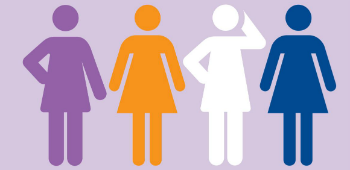
Urogynaecology
Urogynaecology is a sub specialty of Gynaecology. It covers services that provide assessment, investigations and treatment for women with urinary incontinence, vaginal prolapse, recurrent urinary tract infections, bladder pain and pelvic floor injury after childbirth including faecal incontinence. It links with obstetrics, urology and colorectal services.
Vaginal prolapse
This is where one or more of the organs in the pelvis slip down from their normal position and bulge into the vagina. The front wall, back wall and uterus can prolapse. Treatments for a vaginal prolapse include pelvic floor exercises, vaginal pessaries and surgery to repair the weakness in the vaginal walls or a hysterectomy to remove a prolapsed uterus.
Women who are overweight, have had children, have had a hysterectomy and regularly increase their intra-abdominal muscles through straining (constipation) are at an increased risk of developing a vaginal prolapse. Women may also notice that they develop a prolapse around the time of the menopause.
Urinary incontinence
There are two main types of incontinence.
Stress urinary incontinence: leakage with coughing, sneezing, exercising
Stress urinary incontinence happens when there is a rise in intra-abdominal pressure and the pelvic floor isn’t strong enough to combat it. Treatments include pelvic floor exercises (or strengthening the pelvic floor with the use of electrical stimulation) and surgery.
Overactive bladder: urgency, frequency, urge incontinence and nocturia
Treatments for an overactive bladder include fluid advice, bladder retraining and pelvic floor exercises. Drugs, such as (solifenacin and mirabegron) may also improve symptoms. If these don’t improve things then Botulinum toxin injections into the bladder or tibial nerve stimulation may be considered following urodynamic investigations.
Women can also suffer with voiding difficulties. These occur when the bladder isn’t able to empty properly. Constipation, fibroids, vaginal prolapse, surgery, urinary tract infections are all causes. Intermittent self-catheterisation is used to allow the patient to empty their bladder fully.
Menopause
Women often notice that their pelvic floor symptoms start around the time of the menopause. This is when the amount of oestrogen produced in the body is reduced. Topical vaginal oestrogens can often help to improve vaginal health, make sex more comfortable and reduce the likelihood of urinary tract infections. See: Menopause.
The menopause is a key milestone in women’s lives. These pocket cards have been developed by the RCN to help nurses provide women with information on living well and how to positively manage the menopause.
Where should women with pelvic floor dysfunction seek help?
Women should seek help initially from their GPs. Some women are able to self- refer to continence advisors or pelvic health physiotherapists for conservative treatments. Some women will need to be referred by the GP to access these services. Often GPs will fit ring pessaries and will refer up to the urogynaecology team in secondary care for more complex prolapses and for women who haven’t responded to conservative treatments who need further assessment and investigations.
Bladder and bowel care
A joint Bladder and Bowel Care and Childbirth Project from the RCN Midwifery, Woman’s Health and the Bladder and Bowel care forums created clinical evidence based online guidance for registered nurses, midwives, maternity support workers (MSWs) and nursing associates (NAs) looking at bowel and bladder care of pregnant and postnatal women. See: RCN (2024) Bladder and Bowel Care in Childbirth.
Nurses role in urogynaecology
Many of the treatments available for women with pelvic floor dysfunction can be delivered in nurse-led clinics. There is plenty of opportunity to develop extended skills. Many urogynaecology nurse specialists have undertaken training in urodynamics, pessary fitting and removal, flexible cystoscopies and have completed their non- medical prescribing course.
Career pathway
There isn’t a specific pathway into urogynaecology. Many nurses work or have worked in gynaecology or urology. Nurses wanting to develop a specialism in urogynaecology should be motivated, keen to learn new skills, be able to work independently and under pressure. Urodynamic courses are available to gain competency in undertaking the test independently, but there are few courses available to learn pessary fitting and changing. Nurses often learn how to manage pessaries by observing more experienced colleagues.
There are many opportunities to work with the multidisciplinary team. Women’s health physiotherapists play a vital role in providing pelvic floor exercises to women with pelvic floor dysfunction. Many joint pelvic floor multi-disciplinary meetings are held involving urologists, colorectal surgeons and urogynecologists where complex cases are discussed and often managed together.
Nurses often learn how to manage pessaries by observing more experienced colleagues. A new pessary guideline has been developed and published by the UKCS to help standardise pessary training and management. The guideline contains a training document and comprehensive guideline detailing pessary sizing, selection and management of complications with infographics, flow charts and videos to be used in practice. See below for link to the guideline.
Further resources
Guidance
- NICE (2019). Urinary incontinence and pelvic organ prolapse in women: management NG123
- NICE (2021). Pelvic floor dysfunction: prevention and non-surgical management
- RCN (2024). Bladder and Bowel Care in Childbirth
- United Kingdom Continence Society (UKCS) (2021). UK Clinical Guideline: for best practice in the use of vaginal pessaries for pelvic organ prolapse
- United Kingdom Continence Society (UKCS) (2018). Minimum standards for urodynamic studies
- North Bristol NHS Trust. Basic Urodynamics Course
- North Bristol NHS Trust. Certificate in Urodynamics Course
Useful websites
- Age UK
- Association for continence advisors (ACA)
- Bladder & Bowel UK
- Bladder Health UK
- British Society of Urogynaecologists (BSUG)
- British Society of Urology Nurses (BAUN)
- Choudini, J. (2023) Pelvis Floor Support - The PF Platform
- Incontinence UK
- International Urogynaecological Association (IUGA)
- Pelvic, Obstetric and Gynaecological Physiotherapy - POGP booklets.

RCN resources
- Women's Health Forum
- Women's health library subject guide
- The professional lead for women's health is Carmel Bagness.
Page last updated - 08/10/2025





